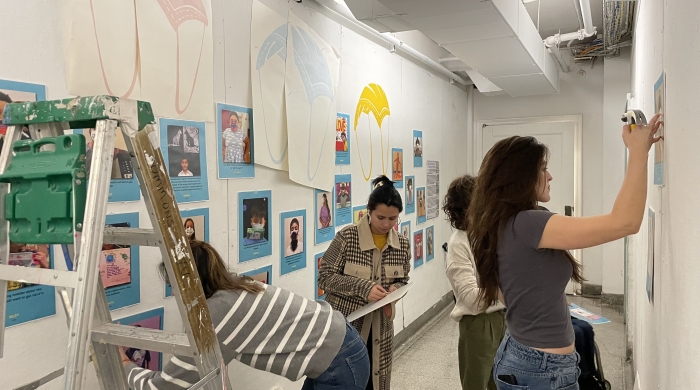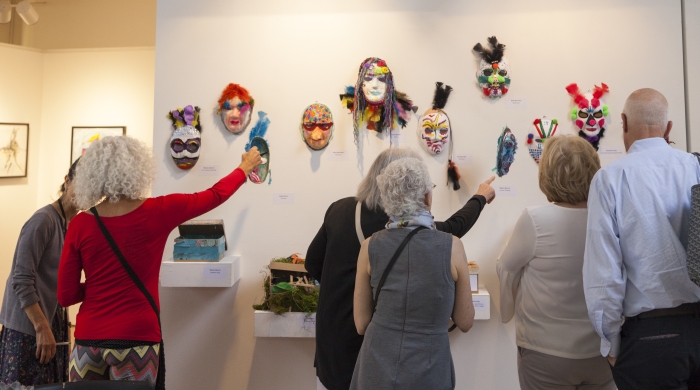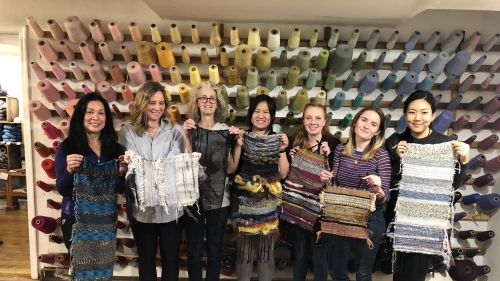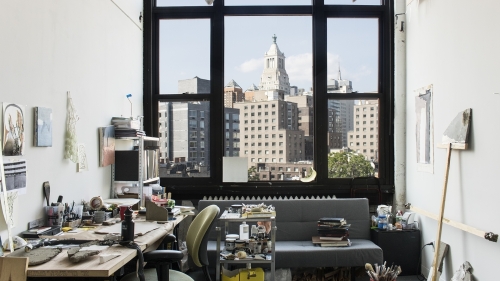NYU Steinhardt’s Art Therapy program blends clinical efficacy with holistic wellness for communities across the City – and the world.
“The body has an intrinsic desire and propensity to create,” said Director of Art Therapy Marygrace Berberian. “Artmaking is a really embodied form of healing. For decades, the medical industry has focused on pathology – you have a symptom, or a deficit, and medicine is about addressing the thing that’s wrong. In contrast, creative arts therapies are about shifting the perspective to see what we can do to strengthen the vital part of people rather than focusing on their deficits. It’s a very holistic approach, and a very whole-body approach.”
Aiding Children in Distress
One of the program’s hallmark initiatives is the NYU Art Therapy in Schools Program, a pioneering project that has offered free art therapy to at-risk students in New York City public schools since 1997. Through this partnership, Art Therapy graduate students gain faculty-supervised training and experience, while public school students in distress receive long-term treatment that would not otherwise be accessible – all while creating more than 200 new works of art each week.

Art Therapy in Schools has offered free art therapy to at-risk students in New York City public schools since 1997.
The Art Therapy in School initiative’s post-crisis therapeutic care extends far beyond the City, however. In the aftermath of the Covid-19 pandemic, faculty in the program sought to find a way to transform the disaster into an opportunity for post-traumatic recovery. Thus, the Parachute Project was born, inviting children and adolescents to explore how they grew during the pandemic by “upcycling” surgical masks with drawings and art.
“It’s been really powerful to see how the mask, which is something that might seem scary to these children, can be transformed into a parachute – something that can help us land gracefully,” said Berberian.
Over 1200 masks have been upcycled and contributed to the Parachute Project, which includes a facilitator’s guide for teachers and parents and a self-guided reflection tool for anyone who would like to join in. As a result of its positive impact, the Parachute Project was included as part of the “Mental Health Prevention and Promotion in Schools and Learning Environments” event, organized by UNICEF, WHO, and UNESCO.
Leveraging Collaboration and Innovation
Berberian cites collaboration and innovation as key to the success of the Art Therapy program and its students.
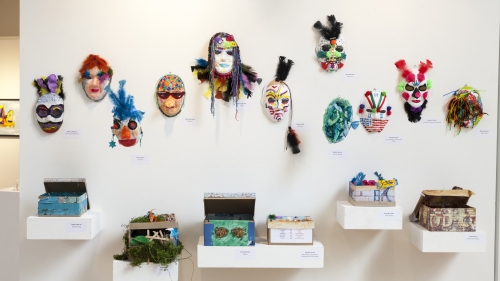
An exhibition in the Barney Building presented as part of a collaboration between neurologists at the Fresco Institute for Parkinson’s and Movement Disordersat NYU Langone and the Art Therapy Program.
“In the past 30 years, there has been a really significant rise in the potential of art therapy that correlates to advances in neuroscience. We can look at brain scans and other qualitative and quantitative tools and understand the physical changes that art has on the body, and the rehabilitative potential of art therapy. At NYU Steinhardt, we are constantly collaborating, not just across the Art and Art Professions Department or the School but across the entire University, so that we are both providing therapeutic care and gathering more information about its effectiveness.”
Collaboration between the Art Therapy program and NYU Langone Health has already proved fruitful, with the Art Therapy and Parkinson’s study, which explored the rehabilitative potential of art therapy for people with Parkinson’s disease, yielding promising results.
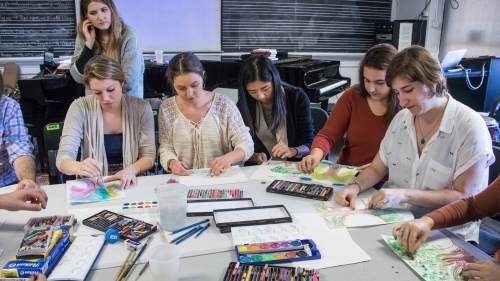
MA Art Therapy Students working on art project workshop.
“Parts of the neural path in the brain get damaged and we can’t do anything about it,” said Ikuko Acosta, clinical associate professor of art therapy. “But somehow the over-and-over creative experience [of artmaking] trains the brain to develop alternative compensatory pathways to bypass the damaged neuropath, developing resilience and problem-solving abilities.”
“Oftentimes people with Parkinson’s disease lose their sense of autonomy,” Acosta continued. “So even the simple experience of making art is an autonomous act.”
Members of the Art Therapy program collaborate with the NYU College of Dentistry to help people with developmental disabilities lower their blood pressure and anxiety prior to dental procedures; implement virtual reality art therapy technology at NYU Langone’s Multiple Sclerosis Comprehensive Care Center; host professional development training for psychologists serving active members of the Ukrainian navy; and provide therapy for asylum-seeking migrant families currently receiving basic care in emergency shelters through the NYC Department of Homeless Services.
“Mental health intervention sometimes ends up coming second to more immediate bodily interventions,” said Berberian. “There are 130 shelters attempting to manage almost 60,000 asylum seekers. We’ve been able to fill some of that need by getting the necessary clearances to go in and work with these families and make art. Some of them share their stories and it’s really powerful.”
“There’s a huge need, and a huge respect for the healing and transformative qualities of art making,” Berberian said. “Only at NYU can you encounter such a range of collaborations, and a range of ways to help.”
Supporting Patients with Chronic Illness
A recent program hosted by Art Therapy, in collaboration with NYU’s Tandon School of Engineering, emphasized this point.
The Art Well Residency provides a nine-week art residency for people living with acute illness, providing a therapeutic space for 20 clients while also seeking concrete data about the effect of art making on participants’ motor skills and psychological wellbeing.
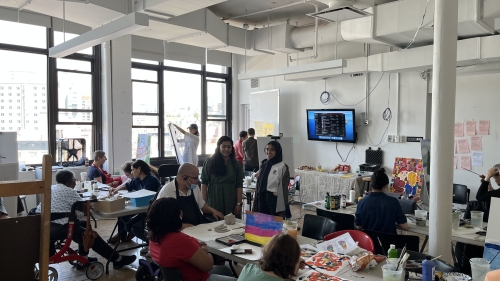
Art Well residents painting in an NYU Steinhardt studio.
As art therapists provide this clinical care, researchers from NYU Tandon’s Creating Connections team – led by Berberian – are in the process of designing a software to measure the participants’ motion fluidity and collect psychological and emotional reports each session. At the end of the residency, students from NYU Steinhardt’s Arts Administration program will curate an exhibit to amplify the artwork – and the clinical results – to the medical community.
Ultimately, Berberian emphasizes, the core of art therapy is an understanding that art is a vital part of health and wellbeing, and seeking to extend art as a resource for those who can benefit from it.
“Many of our students feel a strong call to provide compassionate and responsive care, and that’s what drives them to our program,” she said. “It’s our role to give them the science and the tools to do that well, and to make sure their interventions are ultimately successful.”
Related Articles
Graduate Art Therapy Program Expands Collaboration with the Rubin Museum
Based on past success, the Graduate Art Therapy program has expanded programming at the Rubin Museum, offering free art therapy sessions for the public.
Art Therapy Program Students and Faculty Display the Parachute Project in the Barney Building
The Parachute Project, initiated by the art therapy program, is a contribution to the global effort called for by UNICEF to understand the impact of the pandemic on children and adolescents.
New Steinhardt/Langone Research Published on Art Therapy and Parkinson's Disease
This groundbreaking, innovative study is the first paper exploring the effects of art therapy on Parkinson's Disease in a medical peer-reviewed journal utilizing clinical, behavioral, eye tracking, and brain connectivity outcomes.

